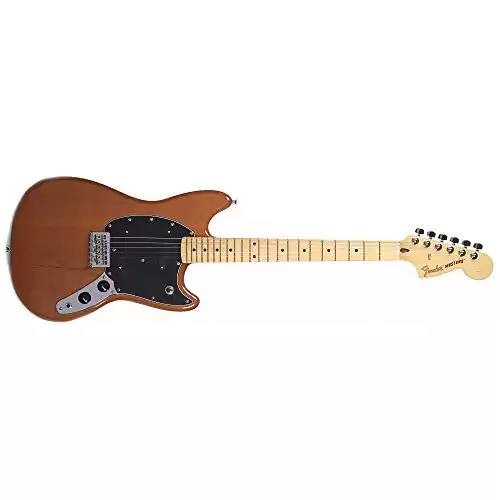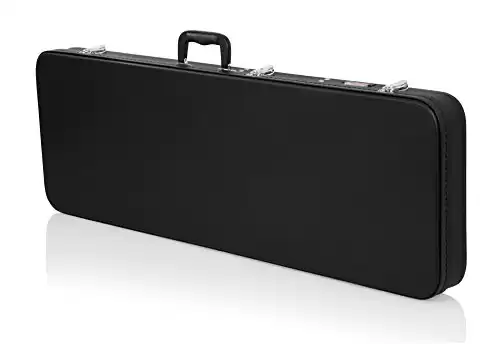There are three guarantees I’ve found that happen in life.
- The government always knows how much money you’ve made, even if you get paid under the table.
- People will always gossip about you when you’re successful because they want to bring you down to their level.
- Someone will come up to tell me how awesome my Fender Jaguar sounded during a gig.
Although it’s always fun to meet people when playing, I never tell people that I’ve got a Jazzmaster I play. Most posers don’t know the difference between a JM and a Jag, although the mistake is sometimes innocent enough.
The offset shape of both guitars lumps them into the same category. People just assume I’d have a Jag, but it highlights a different problem in our industry.
Many people play the guitar of the moment because having something cool distracts listeners from knowing that the individual doesn’t know how to play.
Why Do so Many Posers Play Offset Guitars?
Offset guitars indicate that the instrument’s body is using offset-waist positioning. That means the neck sticks out from the musician more than it would if you had one with a center-waist design. That means you end up leaning into the body more where the top becomes more forward than the bottom.
When people play offset guitars, the goal is to look independent. It’s like telling people that you’re too good to purchase an original Fender or Gibson, so you look for something at the thrift store or pawn shop to stand out.
At best, the look says that you won’t play anything that doesn’t look like it’s been through a trash compactor before reaching your hands.
At worst, the use of an offset guitar makes you look like a poser.
That doesn’t mean you can’t get a great sound from an offset guitar. It all depends on the purpose of your purchase and the overall attitude you have when people approach you to talk about the guitar.
If you want something that delivers a consistent vibrato system, beautiful slow pitch bending, and tone from single-coil pickups, something like the Squier Jazzmaster is the perfect investment.
You’ll still get people who think you’re buying an off-brand label on purpose because of their guitar snobbery, but it doesn’t matter what they believe. You don’t need to play this instrument for long to discover that every brand and model has a certain level of snobbery to manage.
It’s Not the Guitar That’s Junk When Playing Offset
If you’re unfortunate enough to purchase a guitar that’s been owned by the poser guitar, you’ll end up having a showcase item that’s never been played. It’s likely been cleaned with unnecessary chemicals (Windex is the most common choice) and a ton of paper towels.
It looks nice, but it won’t be playable until you go through a complete inspection.
- The neck needs a thorough exam because it’s likely shaped like a banana.
- Cleaning agents likely leaked into the switchgear, including the potentiometers, to create scratchy results for adjustments.
- The screws have never been, making them exceptionally stiff. You might encounter the same problem with the tuners.
You should never purchase a guitar because it provides a specific image. You can play a beat-up guitar to the nines and have people love your style.
It’s also possible to be playing a guitar that glistens because it’s been cleaned daily and has terrible sound and tone.
You should buy a guitar that’s comfortable for your playing style, including offset models. Some people try to fake an indie look by having a Jazzmaster or a Jaguar in their collection. What you need is an instrument that feels good in your hands and around the neck.
If you’re not comfortable with the instrument, you’ll be fighting it every time you try to play. That takes the fun out of gigging with a guitar.
Better Sounds Don’t Change Poor Technique
The issue we have today in the music world is that everyone thinks they can pick up a guitar to play it. People watch a few YouTube instructional videos, subscribe to an app, and put in a month of work.
Once they figure out that their fingers don’t shred a solo like a pro, they look for options that help them fake it until they can make it. In principle, that’s not a bad idea.
In reality, most people just give up their learning curve because they settle for what they feel is a pro-quality sound from an offset guitar.
You can tell the posers right away. They turn the volume and tone all the way to the maximum setting. The vibrato bar never gets used, a switch to the lead circuit occurs, and then the setup routes to the rear pickup so that it’s the only thing you can hear.
That setup leads to nothing more than open strings and droning chords covered in delay, chorus, and terrible distortion. With the instrument buzzing like that, how can you know if any technique is there?
Someone with zero music knowledge might get impressed by these sounds, especially if a song has catchy lyrics and an above-average hook. For everyone else with an iota of playing ability, they’ll see the technique isn’t present.
The fingers aren’t on the frets correctly, the wrong strings get bent, and who knows what other mistakes happen.
It’s tough to respect a musician that flaunts their skills without having any to offer. When someone says that they use this technique to be productive while they’re learning, that’s an entirely different conversation.
I can respect someone who wants to learn. It’s hard to take people seriously when they think they’re the greatest musician ever with a month of video lessons under their belt.
What Are the Benefits of Playing an Offset Guitar?
When you play an offset guitar for authentic reasons, you’ll find that the instrument design can unlock several potential benefits. These advantages provide the reasoning behind its popularity in today’s musical world.
1. More Versatility
Offset guitars offer more versatility with the various switches they offer. If you’ve got a Jag or a JM, the complex circuits make changing between your different rhythm and lead tones incredibly easy.
As the story goes, an executive at Fender saw Alvino Rey perform at a gig and struggle to change from rhythm to lead. That’s how the first Jazzmaster was developed, inventing one of the first solid-body options that let musicians explore multiple approaches.
2. Improved Comfort
Regular guitars offer recesses that end up being directly opposite of each other. The symmetrical design tends to be a little awkward if you’re practicing or playing while seated. That issue occurs because of where your picking hand ends up resting on the instrument.
With the offset design, the recess moves up to six inches in the headstock’s direction, promoting a more comfortable resting position.
This design also shifts some of the weight toward the headstock to help you have a more balanced playing position.
3. Better Playability
The short-scale necks (including three-quarter guitars) make it much easier to play a guitar, especially as a beginner. You’ll have less string tension to manage as part of the experience, making it easier to create vibrato or turn out a solid bend. That means you can offer lots of expressiveness for virtually any musical genre.
You’ll also notice that most offset guitars come with a smoother finish on the neck. That makes the fretboard a lot easier to navigate with your fingers.
4. Tone Changes
The Jazzmaster’s tone is distinctive, which is why it will always be one of my favorite instruments. Although new pickups and different technological advances are creating new sound-generation opportunities, the richness and fullness of the offset design make it desirable for almost any compositional approach.
You can find offset guitars played in bands from Nirvana to independent jazz musicians. Even My Bloody Valentine uses it, which is why so many new musicians want to start playing with that instrument design.
It’s also the reason why you can find lots of brands trying to produce knockoffs that look and sound like a Jag or JM. Some come close if you’re willing to spend some cash, but if you want the best, sticking to the original is your only choice.
Best Offset Guitar to Play Today (That’s Not a Jazzmaster)
Although I’d prefer to play a JM or a Jag when I want to have an offset experience, you can find a few other guitars out there that deliver a similar feel. The best one I’ve found is the Fender Mustang.
This entry-level guitar gives you enough tone and sustain to keep up with the rest of an experienced band. It grows with your playing journey, providing a foundation that lets you find your signature sound.
The combination of maple and alder ensures the tone stays bright and sharp, but there’s enough vintage audio to it that you’ll know you’re playing a Fender. It uses a hardtail bridge and a C-shape neck for a comfortable playing style with a traditional 22-fret design.
It’s a massive single-coil sound that pros will love because it adds distinctiveness to any composition.
Even though it is a three-quarter scale instrument, the weight feels good in the hands. It doesn’t come with a case, so you’ll want to invest in a hard shell one if you plan to transport the instrument to different gigs.
Some people might see you play and call you a poser with the Mustang. Don’t let those words bother you if you’ve got solid technique. If not, it’s time to step up your game.
Is an Offset Guitar the Right Instrument for Me?
Offset guitars come in several varieties today. What they have in common is their asymmetrical body design with exaggerated horns and a waist that lets them seem like they’re leaning away from the player. Fender introduced the original in the 1950s with the Duo Sonic, followed by the Mustang and JM.
The question you need to ask yourself about an offset guitar involves the purpose of the purchase. Are you trying to look cool for others, or do you have legitimate reasons for grabbing one of these popular instruments?
Although several offset body designs are out there, including the Guild S-200 T-Bird and the VI, I’m still a big fan of the Mustang. The Jag and the JM are also excellent choices, and my favorite guitar is the latter option.
After examining the various benefits that come from playing an offset guitar, it’s up to you to decide if one is right for your needs. Just don’t clean it with some Windex.




